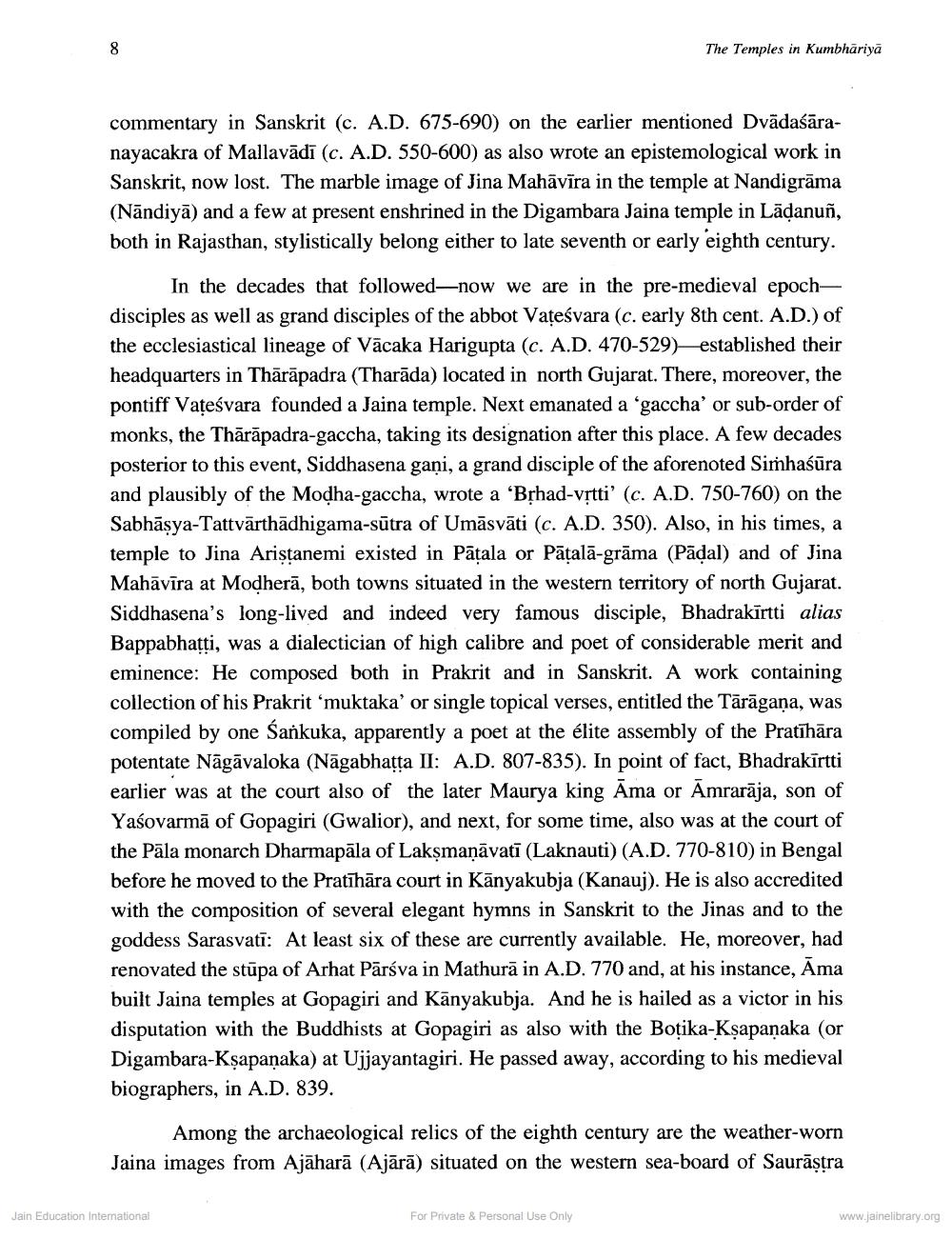________________
The Temples in Kumbhariya
commentary in Sanskrit (c. A.D. 675-690) on the earlier mentioned Dvādaśāranayacakra of Mallavādī (c. A.D. 550-600) as also wrote an epistemological work in Sanskrit, now lost. The marble image of Jina Mahāvīra in the temple at Nandigrāma (Nandiyā) and a few at present enshrined in the Digambara Jaina temple in Lādanuñ, both in Rajasthan, stylistically belong either to late seventh or early eighth century.
In the decades that followed—now we are in the pre-medieval epochdisciples as well as grand disciples of the abbot Vateśvara (c. early 8th cent. A.D.) of the ecclesiastical lineage of Vācaka Harigupta (c. A.D. 470-529) established their headquarters in Thārāpadra (Tharāda) located in north Gujarat. There, moreover, the pontiff Vateśvara founded a Jaina temple. Next emanated a 'gaccha' or sub-order of monks, the Thārāpadra-gaccha, taking its designation after this place. A few decades posterior to this event, Siddhasena gani, a grand disciple of the aforenoted Simhaśūra and plausibly of the Modha-gaccha, wrote a "Brhad-vstti' (c. A.D. 750-760) on the Sabhāsya-Tattvārthādhigama-sūtra of Umāsvāti (c. A.D. 350). Also, in his times, a temple to Jina Aristanemi existed in Pāšala or Pāțalā-grāma (Pādal) and of Jina Mahāvīra at Modherā, both towns situated in the western territory of north Gujarat. Siddhasena's long-lived and indeed very famous disciple, Bhadrakīrtti alias Bappabhatti, was a dialectician of high calibre and poet of considerable merit and eminence: He composed both in Prakrit and in Sanskrit. A work containing collection of his Prakrit ‘muktaka' or single topical verses, entitled the Tārāgana, was compiled by one Sankuka, apparently a poet at the élite assembly of the Pratīhāra potentate Nāgāvaloka (Nāgabhatta II: A.D. 807-835). In point of fact, Bhadrakirtti earlier was at the court also of the later Maurya king Ama or Amrarāja, son of Yasovarmā of Gopagiri (Gwalior), and next, for some time, also was at the court of the Pāla monarch Dharmapāla of Laksmanāvati (Laknauti) (A.D. 770-810) in Bengal before he moved to the Pratīhāra court in Kānyakubja (Kanauj). He is also accredited with the composition of several elegant hymns in Sanskrit to the Jinas and to the goddess Sarasvati: At least six of these are currently available. He, moreover, had renovated the stupa of Arhat Pārsva in Mathurā in A.D. 770 and, at his instance, Ama built Jaina temples at Gopagiri and Kanyakubja. And he is hailed as a victor in his disputation with the Buddhists at Gopagiri as also with the Botika-Ksapanaka (or Digambara-Kșapanaka) at Ujjayantagiri. He passed away, according to his medieval biographers, in A.D. 839.
Among the archaeological relics of the eighth century are the weather-worn Jaina images from Ajāharā (Ajārā) situated on the western sea-board of Saurastra
Jain Education International
For Private & Personal Use Only
www.jainelibrary.org




